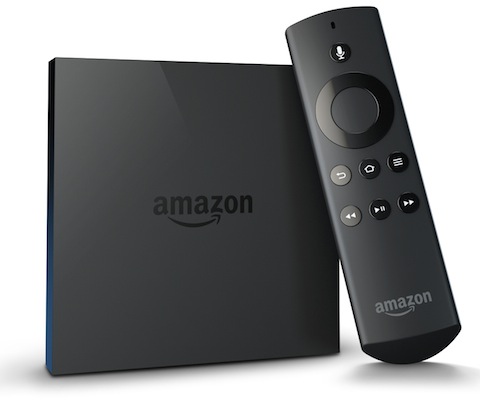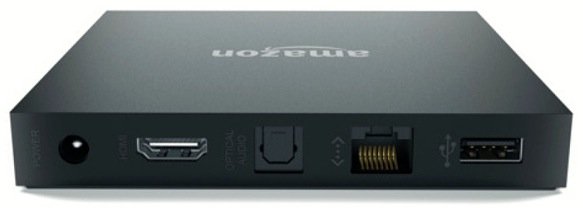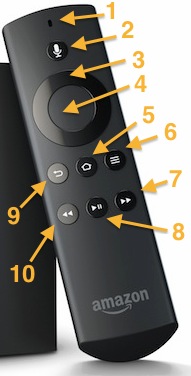Amazon Fire TV: Difference between revisions
| Line 26: | Line 26: | ||
* '''[http://d-h.st/juz XBMC for OUYA 12.3.2]''' | * '''[http://d-h.st/juz XBMC for OUYA 12.3.2]''' | ||
* '''[http://d-h.st/zaP SPMC 12.3.3]''' | * '''[http://d-h.st/zaP SPMC 12.3.3]''' | ||
* '''[http://filez.semperpax.com/5r4ln85l SPMC 12.4.2]''' | * '''[http://filez.semperpax.com/5r4ln85l SPMC 12.4.2]''' (DTS and AC3 working) | ||
* [http://mirrors.xbmc.org/releases/android/arm/ Gotham beta builds] | * [http://mirrors.xbmc.org/releases/android/arm/ Gotham beta builds] | ||
Revision as of 14:48, 11 April 2014
| Amazon Fire TV | |
|---|---|
 | |
| Manufacturer | Amazon.com |
| Released | 2014-04-02 (US) |
| OS | Fire OS 3.0 "Mojito" (Based on Android) |
| CPU | Qualcomm Krait 300, quad-core to 1.7 Ghz |
| Storage | 8 GB internal |
| RAM | 2 GB RAM |
| Display | 1080p |
| Graphics | Qualcomm Adreno 320 |
| Connectivity | HDMI, Bluetooth 4.0, USB 2.0, Wifi (802.11n), 10/100 Ethernet, Optical audio, CEC |
| Dimensions | 115 × 115 × 17.5 mm (4.53 × 4.53 × 0.69 in) |
The Amazon Fire TV is an Android-based (Fire OS) set-top-box that contains a very powerful ARM processor (that can even handle some of the more heavy XBMC skins). Fire TV stands above some of the other Android-based offerings due to Amazon's strong product support and because it contains more remote friendly versions of Netflix, Amazon Prime Video, and other video service clients, making it a good pairing with XBMC.
Builds
Official Builds
XBMC 13 builds for Android (ARM): http://mirrors.xbmc.org/releases/android/arm/
Stable[ish] builds
The following specialized Frodo-based builds are reported to exhibit the fewest issues with hardware video decoding on the Fire TV. They can be installed alongside the below Test build, as they have different package names, so you can still help with testing Gotham.
- XBMC for OUYA 12.3.2
- SPMC 12.3.3
- SPMC 12.4.2 (DTS and AC3 working)
- Gotham beta builds
Installing
General Steps
- Install the Android SDK onto your computer. This contains the ADB tool. https://developer.android.com/sdk/index.html
- Follow these instructions to connect ADB to your Amazon Fire TV: https://developer.amazon.com/sdk/asb/connect-adb.html
- Follow these instructions to install the XBMC app onto the Fire TV (using the ADB tool): https://developer.amazon.com/sdk/asb/app-install.html
Setup ADB on Your Host
Note: Your host must be connected to the same network as your Fire TV..
Windows
- Download and unzip the Android SDK/ADT Bundle for Windows from https://developer.android.com/sdk/index.html
- Find the platform-tools folder in the extracted bundle
- Copy the complete path of the platform-tools, and add it to your PATH environmental variable in Windows System Properties
OS X
To be completed
Linux
To be completed
Android
The ADB utility is built into Android. However, you will need to install a Terminal Emulator app.
Enable USB Debugging on the Fire TV
- From the Fire TV Home screen, select Settings
- Go to System -> Developer Options
- Select ADB Debugging to turn it ON
- Go to System -> About -> Network, and take note of the Fire TV's IP address
Install XBMC to the Fire TV
Note: On OS X and Linux, you may need to prepend ./ to the adb commands.
- On your host (PC or other Android device), download your desired XBMC APK
- Open a Command Prompt (Windows), Terminal (OS X/Linux), or Terminal Emulator app (Android)
- Navigate (CD) to the directory with your XBMC APK
- Run the following commands
- >adb kill-server
- >adb start-server
- >adb connect <ip-address-of-fire-tv>
- ADB is connected when it reports the message "connected to <ip-address-of-fire-tv>:<port>"
- Run the following command
- >adb install <apk-file-name>
- Installation is complete when it reports the message "success"
Launch XBMC on the Fire TV
- From the Fire TV Home screen, select Settings
- Select Applications
- Find and select your XBMC installation (it may be named "XBMC", "SPMC", or "XBMC on OUYA")
- Select Launch Application
Note: Users have reported that you can autostart XBMC after boot using an Android automation apps such as Tasker, AutomateIt, or Llama. Alternately, you can use Autopilot to autoboot to XBMC.
Copying files
Copy userdata settings (optional)
Run XBMC at least once to initialize the userdata folder on the Fire TV
- Copying from PC to Fire TV
- Copy files to Fire TV userdata folder using
adb push <local> <remote>- For example, to copy advancedsettings.xml from your local folder to your Fire TV XBMC userdata folder:
>adb push advancedsettings.xml /sdcard/android/data/org.xbmc.xbmc/files/.xbmc/userdata
- where org.xbmc.xbmc is replaced with your package name such as tv.ouya.xbmc (XBMC for Ouya) or com.semperpax.spmc (SPMC)
- For example, to copy advancedsettings.xml from your local folder to your Fire TV XBMC userdata folder:
- Copying files from Fire TV to PC
- Copy files from Fire TV userdata folder using
adb pull <remote> <local>- For example, to copy advancedsettings.xml from your Fire TV XBMC userdata folder to your local folder:
>adb pull /sdcard/android/data/org.xbmc.xbmc/files/.xbmc/userdata/advancedsettings.xml
- For example, to copy advancedsettings.xml from your Fire TV XBMC userdata folder to your local folder:
You can use adb shell to open a remote shell on the Fire TV. Use standard Linux commands such as cd and ls to navigate the file structure. Type exit to exit adb shell.
See userdata folder for more information on the contents of the userdata folder.
Update Splash Image (optional)
Run XBMC at least once to initialize the userdata folder on the Fire TV
- If the splash image file is splash.png, you can run the following command to copy the file to Fire TV (you may need to update the folder name):
>adb push splash.png /sdcard/Android/data/tv.ouya.xbmc/files/.xbmc/media/splash.png
- If the splash image file is splash.png, you can run the following command to copy the file to Fire TV (you may need to update the folder name):
Here's a splash image created by elmerohueso.
Controls
Bluetooth remote
To make the remote work with XBMC's on-screen-keyboard, go to XBMC -> Settings -> System -> Input devices and enable Remote control sends keyboard presses
Note: For slightly improved keymaps for the Fire TV remote, see Alternative keymaps for Fire TV remote.
CEC
People are reporting that the Amazon Fire TV has basic CEC support.
USB
USB port allows for various additional remote types, such as FLIRC, various RF dongles, etc. Most of these devices will show up as a keyboard type input.
- Logitech K400r, K520, K700 and K800 and DiNovo mini wireless keyboards are said to work, as reported in the forum http://forum.xbmc.org/showthread.php?tid=191109&pid=1673921#pid1673921 (and the next post).
- Logitech DiNovo Edge keyboard works, but touch pad and media keys do not work. DiNovo Edge doesn't have a menu key.
- MCE (IR) remote - 2nd generation works. Turn on the Fire TV after plugging in the IR receiver and it should work.
- IOGEAR GKM561R wireless keyboard/mouse combo works (although Shift/Capslock does not in 12.x, apparently an issue addressed on Gotham)
- See keyboard controls for how to control XBMC using a keyboard. Additional Fire TV controls goes as followed:
Key Action F11
or "browser search"
media key.Voice Search (Does not send mic audio) F12 Fire TV home screen Ctrl+Alt+Delete System reset
Other bluetooth devices
It should be possible to pair other bluetooth controllers and remotes to the Fire TV. Most of these devices will show up as a keyboard type input.
Known issues
- Hardware video decoding is semi-working. This is being looked into. Please see the test build section above for how you can help.
Random notes
Feel free to place various notes, tips, and links here. As this section of the wiki gets more organized, those notes will be properly sorted. Consider this like a dumping ground for when you're not sure where to put something.
- The USB port seems to work with keyboards and mice.
Links
- XBMC forum thread about the Amazon Fire TV: http://forum.xbmc.org/showthread.php?tid=191109
- Amazon Fire TV product page: http://www.amazon.com/Amazon-CL1130-Fire-TV/dp/B00CX5P8FC
- iFixit teardown: http://www.ifixit.com/Teardown/Amazon+Fire+TV+Teardown/23856
- Supported codecs: https://developer.amazon.com/sdk/asb/media-specs.html
- Wikipedia article on Amazon Fire TV: wikipedia:Amazon Fire TV

